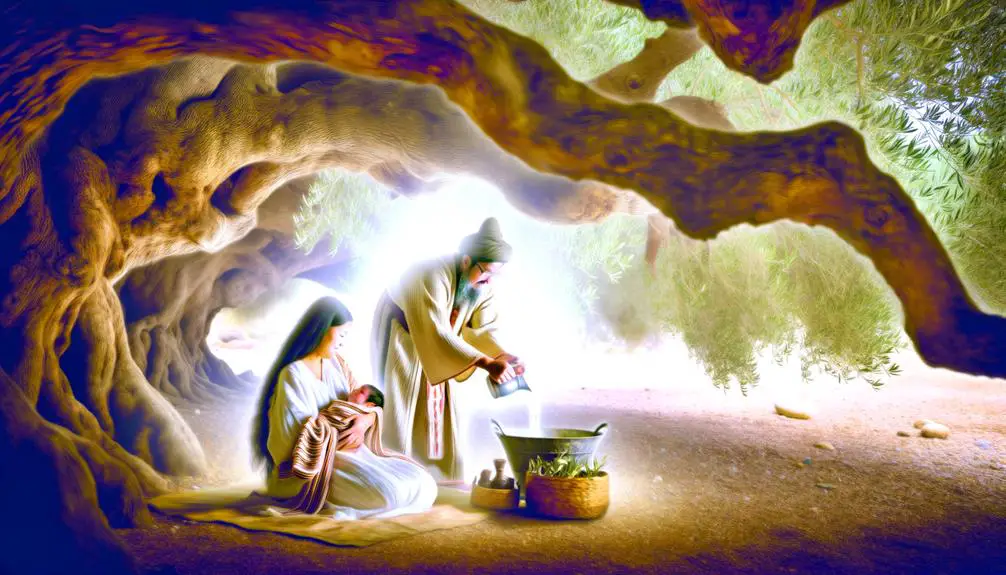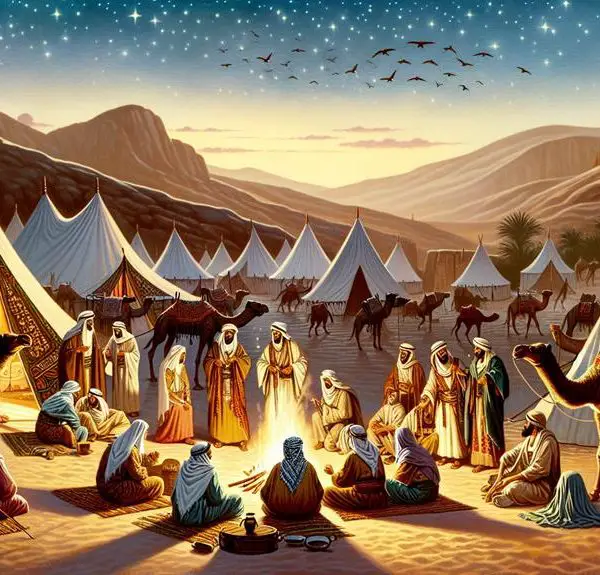Purification rituals after childbirth in the Bible reveal ancient beliefs on purity and motherhood, inviting a deeper exploration into their cultural significance.

Purification After Childbirth in the Bible
When a woman welcomes a new soul into the world, the Bible outlines specific rituals for her purification. You'll find these ancient practices intriguing, as they blend spiritual beliefs with the physical realities of childbirth.
The texts detail a period of seclusion and a series of offerings, pointing to a deep symbolism about purity, community, and the role of women. But why did these rituals come to be, and what significance did they hold in their cultural context?
Exploring these questions will not only illuminate the past but also might shed light on contemporary discussions about purity and motherhood.
Key Takeaways
- Biblical texts prescribe specific rituals and seclusion for new mothers, emphasizing spiritual purification.
- Purification practices vary by culture, reflecting the integration of childbirth into spiritual and communal life.
- Symbolism in purification rituals includes water for cleansing, offerings for gratitude, and ceremonies for societal reintegration.
- Modern interpretations shift focus from impurity to celebrating women's strength and aligning with contemporary maternal health perspectives.
Biblical Basis for Purification

The concept of purification after childbirth is deeply rooted in biblical texts, particularly within the Levitical law, which outlines specific rituals and periods of seclusion for new mothers. This practice, grounded in ancient traditions, reflects the socio-religious fabric of the time, offering a lens through which to explore both historical accuracy and gender perspectives inherent in these sacred writings.
Historical accuracy in the context of purification rites post-childbirth hinges on understanding these practices not merely as religious mandates but as reflections of contemporary societal norms and medical knowledge. Scholars argue that such rituals provided a structured recovery period, acknowledging the physical realities of childbirth within the limitations of ancient healthcare. This perspective underscores the pragmatic, albeit religiously framed, approach to postpartum care, challenging simplistic interpretations of these rites as purely ceremonial.
From a gender perspective, the Levitical laws on purification reveal much about the status and perceived roles of women in ancient societies. These texts, while placing women in a seemingly subordinate religious role, also accord them a specific, recognized space within the socio-religious hierarchy. The requirement for purification, exclusively applied to women, underscores a gendered understanding of purity and impurity, reflecting broader patriarchal values. Yet, it also highlights the significant, if ritually circumscribed, role of women's reproductive functions in maintaining the cultural and religious continuity of the community.
Analyzing the biblical basis for purification after childbirth thus offers valuable insights into the interplay between religious practices, historical contexts, and gender dynamics, revealing the complex layers of meaning behind these ancient texts.
Rituals and Practices

Delving into the rituals and practices of purification post-childbirth, we observe a complex interplay of religious, cultural, and societal norms that governed these rites. These ceremonies weren't monolithic but varied widely, influenced by geographical differences and evolving interpretations of religious texts.
The following list highlights key aspects of these practices, focusing on duration variations and geographical differences:
- Duration Variations: The length of the purification period differed significantly across cultures and historical periods. For example, Levitical law prescribed a 40-day purification period for a mother who'd given birth to a son, and an 80-day period for a daughter. This distinction underscores not just a temporal variation but also a gender-based differentiation in the approach to purification.
- Geographical Differences: The location played a crucial role in shaping the specific rituals and ceremonies surrounding purification. In certain regions, immersion in a mikvah or ritual bath was central, while in others, offerings and sacrifices took precedence. This diversity reflects the adaptation of religious mandates to local customs and environmental conditions.
- Community Involvement: The degree of community involvement also varied, with some traditions emphasizing a more communal approach to purification, involving ceremonies attended by family and community members, whereas others prescribed a more solitary confinement for the mother.
- Ritual Variability: The rituals themselves—ranging from bathing and anointing to the offering of sacrifices—demonstrated a remarkable variety. Each practice carried its own set of meanings and was deeply embedded in the theological and cultural milieu of its time.
These practices, rich in diversity and steeped in tradition, mirror the ways in which communities navigated the sacred act of childbirth, integrating it within their spiritual and social fabric.
Symbolism and Significance

Moving beyond the diverse practices of post-childbirth purification, it's crucial to explore the rich symbolism and significance these rituals hold within their respective cultures and religious contexts. You'll find that these practices aren't just about physical cleanliness but are deeply imbued with meanings that touch on gender dynamics and spiritual renewal.
Aspect |
Symbolism |
Significance |
|---|---|---|
Water |
Cleansing |
Represents spiritual renewal and the washing away of the past, preparing the mother for a new chapter in life. |
Time |
Transition |
Marks the period of transition, reflecting on the transformation from childbirth back to societal norms, emphasizing the importance of this change in status. |
Offerings |
Gratitude and Sacrifice |
Express gratitude towards the divine for the safe delivery and survival of mother and child, also acknowledging the sacrifice involved in childbirth. |
Seclusion |
Reflection and Protection |
Offers a period for the mother to reflect on her experience and bond with her child, while also protecting her from external impurities. |
Ceremony |
Community Reintegration |
Symbolizes the reintroduction of the mother into the community, highlighting the completion of her journey and the acceptance of her new role. |
These rituals underscore the complex interplay between physical purification and spiritual cleansing, emphasizing the importance of both in the aftermath of childbirth. They not only focus on the mother's return to a state of purity but also celebrate her spiritual renewal and readiness to embark on the journey of motherhood. Furthermore, they reflect gender dynamics within the community, illustrating the roles and expectations placed upon women and their significant contributions to the continuity of cultural and spiritual traditions.
Cultural Context

Understanding cultural contexts is crucial in comprehensively analyzing the multifaceted rituals of purification following childbirth, as these practices are deeply embedded within the societal and religious frameworks that shape them. These rituals weren't mere religious formalities but were deeply intertwined with the gender roles and social status prevalent at the time.
- Gender Roles: The purification rituals underscored the distinct gender roles entrenched in ancient societies. Women, during the postpartum period, were often secluded, highlighting not only concerns of ritual impurity but also the societal perception of women's roles in procreation and motherhood. This seclusion period was a reflection of the broader gender dynamics and expectations of women's purity and their participation in religious practices.
- Social Status: The duration and nature of the purification process could vary significantly based on a woman's social status. Wealthier families could afford more elaborate purification rituals, which not only reinstated the woman's social status but also reaffirmed the family's position within the community.
- Ritual Significance: Beyond gender and social status, these rituals served to reintegrate the woman into society and religious life. The act of purification was a rite of passage that marked the end of one phase of life and the beginning of another, underlining the importance of community and belonging in ancient cultures.
- Societal Frameworks: The societal and religious frameworks governing these practices were indicative of the values, beliefs, and norms of the time. Understanding these contexts allows for a deeper appreciation of the complexity and significance of postpartum purification rituals.
Modern Interpretations

In contemporary discourse, scholars and theologians re-evaluate the biblical purification rituals after childbirth, exploring their relevance and reinterpretation in modern society. You're witnessing a fascinating shift as these ancient practices are dissected through the lenses of gender dynamics and medical perspectives, revealing a complex interplay of tradition and progress.
Aspect |
Traditional Interpretation |
Modern Reinterpretation |
|---|---|---|
Gender Dynamics |
Highlighted women's impurity and separation |
Focuses on women's strength and resilience |
Medical Perspectives |
Seen as a lack of understanding of childbirth |
Viewed as an early recognition of postpartum recovery |
Social Implications |
Reinforced gender roles and segregation |
Encourages discussion on gender equality in rituals |
Spiritual Significance |
Emphasized purification and reintegration into society |
Explored as a metaphor for new beginnings |
This table showcases the pivot from traditional to modern interpretations, emphasizing a more inclusive and enlightened approach. You're encouraged to see beyond the literal implications of these rituals, understanding them as early societal attempts to navigate the complexities surrounding childbirth.
The shift towards viewing these rituals through a gender dynamics lens challenges the historically patriarchal interpretations, advocating for a recognition of women's power rather than focusing on notions of impurity. From a medical standpoint, modern scholars suggest that these practices could be seen as an acknowledgment of the need for postpartum care, a concept that aligns with contemporary understanding of maternal health.
As you delve deeper into these modern interpretations, it becomes clear that the conversation is not just about religious practices but also about how society values and understands gender, health, and spiritual renewal in the context of childbirth.
Frequently Asked Questions
How Has the Scientific Understanding of Childbirth and Postpartum Recovery Impacted Religious Views on Purification After Childbirth?
Your exploration into how scientific advances, particularly from a microbial perspective and understanding hormonal adjustments, have influenced religious views on postpartum purification reveals a complex interaction.
As science sheds light on the biological processes involved in childbirth, some religious practices have adapted, integrating these insights to reinterpret traditional rituals.
This blend of knowledge allows for a more informed approach to postpartum care, respecting both health and spiritual beliefs.
Are There Any Documented Cases or Historical Records of Individuals Who Challenged or Refused to Undergo These Purification Rituals, and What Were the Consequences They Faced?
Curiously, you're exploring cases where individuals bucked the trend, refusing post-childbirth purification rituals. This defiance illuminates the ritual origins and social dynamics at play.
Historically, those who challenged these norms often faced harsh consequences, underscoring the rituals' deep societal roots. Analyzing these instances provides a scholarly glimpse into how ritual adherence and rebellion shaped community cohesion and individual identity, emphasizing the complex interplay between tradition and personal belief systems.
How Do Different Branches of Christianity Interpret and Practice Purification Rituals After Childbirth Today, if at All?
Today, you'll find that different branches of Christianity show interpretative variations in practicing purification rituals after childbirth, if they observe them at all. These ceremonial differences stem from diverse theological perspectives and cultural influences within each denomination.
Some may hold closely to traditional rites, while others offer modern, symbolic gestures or none. It's crucial to analyze how these practices reflect broader doctrinal beliefs and the evolving nature of religious observance.
What Are the Psychological Effects on New Mothers Subjected to or Exempt From These Purification Rituals, According to Modern Psychology?
You're diving into how modern psychology views the impact of childbirth purification rituals on new mothers. These practices can play a significant role in emotional well-being, potentially affecting postpartum depression rates.
When you're included in these rituals, it might offer a sense of community and support, buffering against isolation. Conversely, being exempt can intensify feelings of cultural stigma, possibly exacerbating postpartum depression.
It's a nuanced interplay between tradition, personal beliefs, and mental health.
How Do Non-Abrahamic Religions and Cultures Address the Concept of Purification After Childbirth, and What Parallels Can Be Drawn to the Biblical Practices?
Curious how other cultures approach postpartum purification? Many, like the Hindu Samskara, emphasize rites of passage that spiritually cleanse and prepare new mothers. Indigenous practices often involve holistic rituals, connecting mother and child to nature and community. These traditions offer fascinating parallels to biblical practices, focusing on renewal and integration.
Analyzing them, you'll find a universal thread—rituals that honor the transformative journey of childbirth, underlining our shared human experience.
Conclusion
In the tapestry of biblical narratives, the purification ritual after childbirth weaves a thread of deep symbolism, connecting the physical to the spiritual. This ancient practice, cradled in cultural context, serves not just as a rite of passage but as a mirror reflecting society's view on birth and renewal.
Today, its echoes in modern interpretations invite us to ponder the sacred dance between life's beginnings and the profound rituals that honor them. In this scholarly exploration, one finds that these rituals aren't mere historical footnotes but vibrant, living traditions that continue to shape our understanding of purity, community, and the divine.


Sign up